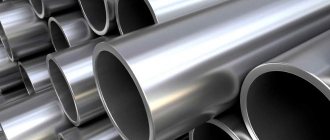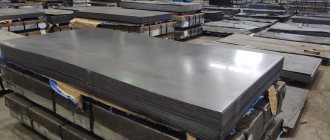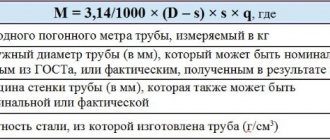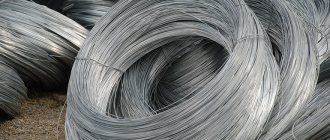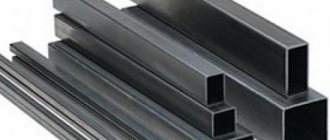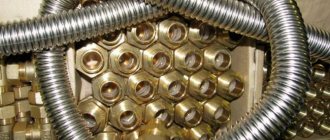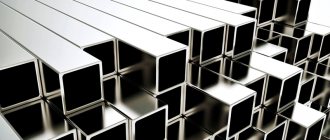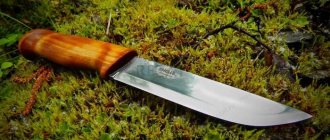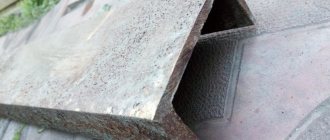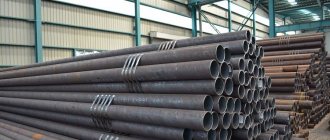Reading time: 9 minutes. Updated
Stainless steel pipe according to GOST is a product made of corrosion-resistant steel, which is widely used in various fields. These are the construction, food, chemical production and oil sectors. In addition, they are used in electric power and pulp and paper enterprises.
Outstanding characteristics, namely: resistance to aggressive substances, strength, durability and fire resistance, allow them to be used for a wide variety of tasks.
Recording menu
- GOST standards and types of rolled metal products
- Profile stainless steel
- Rectangular and square stainless steel
- Requirements for this range
- How is finished goods accepted?
- Products 19277
- Dimensions
- Areas of use
Types of products and areas of their use
For the production of profile stainless steel pipes, complex alloy steel grades with a high content of chromium (17 - 19%) and carbon impurities (0.8%), titanium (0.5%), and nickel (8-10%) are used.
The alloying elements included in the alloy give these products:
- unusually high resistance to corrosive destruction;
- increased strength and wear resistance;
- good weldability;
- high technology;
- long service life without changing the original properties;
- aesthetic appearance;
- resistance to thermal influences;
- good impact strength;
- resistance to low temperatures;
- complete passivity to chemicals.
1.1. Types of rolled pipes
Stainless steel pipes are manufactured with a cross section of different shapes, depending on which there are:
- round;
- oval;
- square;
- rectangular.
According to forming technology, rolled stainless steel grades are divided into:
- welded;
- hot rolled;
- heat-deformed;
- cold drawn pipes.
Depending on the type of surface treatment, they can be:
- polished;
- matte;
- polished to a mirror finish.
Attention! High-quality products on the outer and inner surfaces should be free of cracks, deep marks, over-etching, penetration, flaws and caps.
1.2. Application of stainless steel pipes
Durability of use and excellent technical characteristics of rectangular pipes made of stainless steel alloys make them in demand in many areas of the national economy
:
- in the construction industry;
- automotive industry;
- furniture production;
- oil and gas industry;
- public utilities;
- production of medical instruments;
- for the construction of pipeline systems and equipment in chemical and food industries.
However, there are some restrictions on the use of certain types of pipes. For example, welded products with a rectangular and square cross-section cannot be used for the construction of pipelines intended for transporting media under high pressure.
Stainless steel pipes with a matte surface are used for the manufacture of metal structures, for which there are no special requirements for aesthetic appearance.
Products with a mirror surface are endowed with decorative qualities, so they are used in the manufacture of furniture and interior design. Mirror pipes 30x10x 1.5 mm can be purchased for installing fences, railings, cornices and canopies.
Stainless steel pipes with a rectangular profile and low weight have high strength characteristics and resistance to torsional forces.
They are used for the manufacture of:
- load-bearing metal structures: racks, beams, columns, trusses;
- frames of various configurations;
- vaulted structures;
- supports for equipment;
- stairs, etc.
This is interesting: Dowels for concrete and brick: parameters and installation nuances
Advantages and disadvantages
Stainless steel profile pipes have the following qualities and advantages:
- High strength characteristics with low weight.
- Due to the flat edges, they are more convenient to install than round profile pipes.
- Resistant to temperature changes.
- The ability to withstand any type of load (transverse, tensile and torsional), since they are distributed to the walls at right angles.
- High corrosion resistance, long service life.
- Heat resistance.
- Good weldability.
- Aesthetic appearance.
- Wear resistance.
- Frost resistance.
- Completely inert to chemical influences.
The disadvantages of profile products include:
- Relatively high cost.
- Inability to use for water supply pipelines and heating system wiring.
Classification
Stainless steel pipes vary in geometric characteristics depending on the diameter and cross-sectional shape of the pipe, as well as the type of surface treatment. The cross-sectional shape of the pipes can be round, square and rectangular. According to the type of processing, they are divided into:
- Matte
- Sanded
- Polished
The thickness of the pipe wall allows stainless steel pipes to be divided into thick-walled with great strength and thin-walled. Thin-walled pipes are characterized by high flexibility, so they are necessary for the manufacture of complex structures.
Available Sizes
10x10x0.810x10x0.910x10x110x10x1.210x10x1.415x15x0.815x15x0.915x15x115x15x1.215x15x1.415x15x1.520x20x0.820x20x0.920x20x120x 20x1.220x20x1.420x20x1.520x20x225x25x0.825x25x0.925x25x125x25x1.225x25x1.425x25x1.525x25x225x25x2.525x25x330x30x0.830x30x0.93 0x30x130x30x1.230x30x1.330x30x1. 430x30x1.530x30x230x30x2.530x30x330x30x3.530x30x432x32x435x35x0.835x35x0.935x35x1.435x35x1.535x35x235x35x2.535x35x335x35x3. 535x35x435x35x536x36x440x40x1.440x40x1.540x40x240x40x2.540x40x340x40x3.540x40x440x40x540x40x642x42x342x42x3.542x42x442x42x542 x42x645x45x245x45x345x45x3.545x45x445x45x545x45x645x45x745x45x850x50x250x50x2.550x50x350x50x3.550x50x450x50x4.550x50x550x50x6 50x50x750x50x855x55x360x60x260x60x2.560x60x360x60x3.560x60x460x60x560x60x660x60x760x60x865x65x670x70x370x70x3.570x70x470x70x5 70x70x670x70x770x70x880x80x380x80x3.580x80x480x80x580x80x680x80x780x80x880x80x980x80x1080x80x1190x90x390x90x490x90x590x90x690 x90x790x90x8100x100x3100x100x4100x100x5100x100x6100x100x7100x100x8100x100x9110x110x6110x110x7110x110x8110x110x9120x120x6120x1 20x7120x120x8120x120x9140x140x6140x140x7140x140x8140x140x9150x150x7150x150x8150x150x9150x150x10180x180x8180x180x9180x180x1018 0x180x12180x180x14
Production Features
In the production of stainless rectangular and square pipes, two main technologies are used: obtaining finished metal products from a flat-shaped workpiece and profiling a round pipe.
2.1. Seamless products
The technical conditions for the manufacture of profile seamless cold- and heat-deformed stainless steel pipes are established by GOST 9941-81, hot-deformed pipes - by GOST 9940-81. For production, bored and turned round pipes are used - blanks. They acquire the required dimensions when passing through calibrating rollers.
At the last stage of production, rolled pipe is cut into pieces of a certain length and goes through:
- heat treatment, control of surface quality and geometric parameters (each product);
- checking for intergranular corrosion and tensile testing (two pipes from a batch);
- quality control for flattening (one product from a batch).
Rectangular stainless pipes in accordance with GOST 19277-73 have the length:
- unmeasured - from 1.5 to 7 m;
- dimensional - in the interval of non-dimensional;
- a multiple of the measured one, in the unmeasured range with an allowance for each cut of up to 5 mm;
- measured with remainder (not shorter than 1 m).
Attention! The length of finished products cannot exceed the established standards by more than 10 mm.
2.2. Electric welded rolled products
The technical conditions for the production of electric-welded rectangular stainless steel pipes are determined by GOST 11068-81. High precision of manufacturing and finishing is regulated by GOST 26877-2008. The chemical composition of the steel alloy is determined according to GOST 5632-72.
During the production process, steel sheet (strip) is formed using a sheet bending machine into a round blank with open edges. The seam is then welded using induction current or TIG welding, which can provide greater strength to the joint. A rectangular profile is given to the finished product using sizing rollers.
Attention! Non-destructive methods are used to check the continuity of the weld.
Length of products in accordance with the requirements of GOST 11068-81:
- measured - from 5 to 9 m;
- unmeasured - from 1.5 to 9 m;
- multiple of the measured one - no more than 9 m with an allowance of 5 mm for each cut.
Main technical characteristics of professional pipes
Production technology : electric welded and seamless, obtained by hot or cold rolling;
Section geometry : width, height, rounding radius;
Wall thickness and metal content : standards indicate the mass of 1 meter;
Sectional area : the corrugated pipe performs a load-bearing function, so preliminary calculation of loads is important;
Moment of inertia and moment of resistance (cm³) : used in calculations of bending strength;
Length : measured, unmeasured, multiple of measured.
Profiles made from steel strip have one straight seam, which can be considered as a vulnerability: the heat-affected zone is characterized by lower corrosion resistance and higher stress. Solid seamless rolled steel does not have such disadvantages.
Characteristics of electric welded pipes
International standards: electric welded pipes made of austenitic steel grades ASTM A554, A270, A312, A249, A269, DIN 17457, 17455 Seam welding type - TIG, laser seam. Surface: • Matte • Sanded (180, 320, 400 Grit) • Mirror (400,600 Grit)
Symbols for determining the surface type of an electric-welded pipe
| Surface type | Designation | |
| Matte | Matt, Mill finish | Matte |
| Sanded | Brushed | Cleaned, primary grinding |
| Satin 180 Grit Satin 320 Grit Satin 400 Grit | Grinding degree | |
| Mirror | Mirror 400 Grit Mirror 600 Grit | Polishing degree |
Shape: • round • profile Length: 6 m (custom pipes of any length can be supplied to order). Standard sizes: • diameter from 6 mm to 325 mm • cross-section from 10x10mm to 300x300mm, 400x200mm Wall thickness: from 0.8 mm to 6 mm
This is interesting: Packaging steel tape - application, characteristics, production
Rectangular stainless steel pipes with polished surface
As the name of such profile pipes suggests, they have a surface that is polished after production of the product. Grinding is carried out using abrasive material with a grain size of 180–320 and allows not only to give the steel exceptional decorative properties, but also to increase its resistance to corrosion.
This technological operation makes it possible to achieve high uniformity of color on the surface of the profile pipe, as well as to eliminate the presence of defects on it, which are often found on mirror-type pipe products. At the same time, in terms of decorativeness, such pipes are in no way inferior to mirror ones, and often even surpass them in this indicator.
It should be noted that for stainless steel pipes with profile dimensions from 100x100 mm and above and a wall thickness of 2.5 mm, a technological operation such as grinding is the only possible way to improve the decorative characteristics.
It is also necessary to keep in mind that the part of the weld that is located in the inner part of the pipe is not subject to grinding.
Areas of application of electric welded pipes
• Heat exchangers and heaters • Decorations, structures • Petroleum and chemical industry • Food industry • Shipbuilding and mechanical engineering • Water transportation systems
Product standards, according to intended use (welded stainless steel pipes)
| USAGE | EN Euro Norm | SS | ASTM-ASME | DIN | NFA | GOST |
| Chemical industry | EN 10217-7 | 219711 219713 | A 358-SA 358 A 312-SA312 A 269-SA 269 | 17457 | 49147 | GOST 11068-81 |
| Food products | EN 10217-7 | A 270 | 11850 | 49249 | ||
| Heat exchanger | EN 10217-7 | 219711 219713 | A 249-SA 249 | 17457 2818 | 49247 49244 | GOST 11068-81 |
| Pipeline | EN 10217-7 | A 778 A 269 | 17455 | 49147 | ||
| Drinking water | EN 10312 | DVGW541 | ||||
| Decoration, design | EN 10296-2 | A 554 | 17455 2395 | 49647 |
GOST standards and types of rolled metal products
The production method in this case depends on the requirements of GOST. For example:
- GOST 9941 81 defines the production method that results in stainless steel electric-welded pipes.
A narrow ribbon is created from the raw material, and it is wound onto a drum shaft. In it, the future pipe blank is bent into a cylinder. Its extreme parts are welded using one of the welding methods.
This can be an electric arc, an electron beam, the use of high-frequency points, plasma or laser. The “bundles” option in the manufacture of electric-welded stainless pipes is not used very often, as it is quite expensive, because all technical processes are performed in a vacuum.
Electric-welded metal products are used for the manufacture of pipelines and various structures.
The length of electric-welded pipes is as follows: measured length - from 5 to 9 meters; unmeasured length - from 1.5 to 9 m. The limit deviation in the length of types of short and measured lengths cannot exceed +15 mm.
The specified regulatory document applies to types of electric-welded pipe assortment with wall dimensions from 0.7 to 5 mm.
- Seamless stainless steel pipes are also produced in accordance with GOST.
The raw material base for a seamless product is round blanks obtained by casting or pressing. Production according to the standards includes a couple of stages of “running” through rollers. In them, the pipe receives the required dimensions and volume. Next, the seamless products are calibrated and cut into pieces of the required size.
The following types are determined by temperature conditions: cold-deformed; heat deformed; hot-deformed. The first two types of seamless pipe materials are standardized by document - 9941 81.
These are options with an external volume from 0.6 to 27.4 cm, and wall dimensions from 0.3 to 21 mm. For the last type of seamless options, other standards are used, these are 9940 81. Such standards provide for volumes from 58 to 326 mm and wall thicknesses from 3.6 to 31 mm.
IMPORTANT! In practice, the production of stainless steel pipe products is not always limited by standards. By agreement with the client, products can be manufactured with other volume and wall dimensions.
Rectangular stainless steel pipes with a mirror surface
Pipes of this type, for the production of which AISI 304 stainless steel or its domestic equivalent are also used, are exceptionally decorative, which is ensured by their mirror surface. Naturally, they are used for the manufacture of structures whose appearance is subject to increased requirements.
Mirror stainless steel is often used for making furniture and commercial equipment
GOST stainless steel professional pipe
Metal profiles of various types can be used in such critical areas as the construction of cars, ships, airplanes, and even spacecraft. A stainless steel profile pipe produced in accordance with GOST is guaranteed to have the required characteristics.
In stock at the warehouses of the “Regional House of Metal” there is a large assortment of stainless steel profile pipes 40x10 mm and other sizes manufactured in accordance with GOST, with different wall thicknesses and surface types.
- GOST 9940-81 for square products
- The entire range of stainless steel pipes
- Characteristics of stainless steel steel 18/10
- Product polishing
- GOST 5582-75
- Steel pipe
- Stainless steel
- Steel sheet
- Armature
- Long products
- Pipe systems
- Metal structures
- Reinforcing mesh
- Metalworking
- Pipe parts
- Tsvetmet
- Metal-plastic and fittings
- Finishing and building materials
- Plastic pipes
Standard sizes and markings
Marking of profile stainless steel products is applied to their outer side at the factory after manufacturing. It consists of information about the standard size of the product, as well as the steel grade and the manufacturer’s trademark.
For example, let’s decipher the marking 100×100x5 09G2S:
- The first two positions indicate the size of the ribs in mm. In this case, 100 mm and 100 mm, since the pipe has a square profile.
- The third is the thickness of the walls.
- The fourth is the steel grade (set if necessary).
Characteristics of seamless pipes
International standards:
- ASTM A312 - Seamless pipes (c/c) of austenitic stainless steel grades,
- ASTM A213 - Seamless Ferritic and Austenitic Alloy Boiler Parts,
- steam superheating and heat exchange pipes.
Surface: Matte Shape: round Length: 5-7m Standard sizes: diameter from 6 mm to 325 mm Wall thickness: from 1 mm to 13 mm
Application areas of seamless pipes
• General purpose pipes, chemical. and nuclear industry • Heat exchangers • Furnaces and chimneys
Main types
Profile pipes for which stainless steel is used, as indicated by GOST, can be produced using different technologies. Depending on this, they are divided into the following types:
- welded, obtained from rolled sheets;
- made from round pipes using hot-rolled technology;
- made using cold rolled technology.
GOST strictly stipulates the maximum deviations of the geometric parameters of profiled stainless steel pipes, which, in particular, include:
- right angles forming the profile (the deviation in this parameter cannot exceed 1.5° in any direction);
- curvature measured on a surface segment of 1 meter (no more than 2 mm).
In the assortment of stainless steel profile pipes you can find a product of a suitable shape and size
The modern market offers a wide variety of types of profile pipes made of stainless steel. It is worth dwelling in more detail on the characteristics of the most popular and sought-after types of such products.
Square stainless steel pipes with matte surface
Stainless steel pipes of this type, which are produced primarily using welding technology, are used in cases where high demands are not placed on the decorative properties of structures. These, in particular, may be:
- racks installed in warehouse or production areas;
- structures that will be hidden from view during operation;
- work sites;
- supporting elements for various purposes.
Manufacturing gates from profile stainless steel pipes with a matte surface
For the production of such profile pipes, steel grade 08Х18Н10 or its foreign analogue AISI 304 is used. The use of stainless steel sheets with a matte surface, as well as high-speed welding technology using high-frequency currents, can significantly reduce the cost of this product. In some cases, when it is necessary to produce square pipes from sheet metal whose thickness exceeds 4 mm, another welding technology can be used - TIG/Laser.
AISI-304 stainless steel is easy to weld and does not require subsequent heat treatment
Requirements for this range
Stainless steel pipes GOST 9941 81 are manufactured in compliance with the following requirements:
- The extreme parts of the finished product are cut at right angles, and they are carefully cleaned of burrs. This sometimes causes a slight roughness to appear on the surface and a chamfer is formed. The described standards allow the presence of such formations. Often, customers specifically discuss with the manufacturer the presence of a chamfer on a product that has a wall thicker than five mm, as this makes it possible to more effectively fasten the structure together by welding.
- On a meter-long piece, these pipes may have a slight curvature. This is two millimeters for a structure with a wall of 0.05 cm and a cross-section of 1.5 cm. It is also one millimeter for options with a wall of more than 0.05 cm and a cross-section of more than 0.5 cm.
- The steel grades taken for the work for these pipes may contain small inclusions of metals belonging to the rare earth group. But sulfur may contain no more than 0.02%.
- All finished products must undergo heat treatment. This is not carried out only by individual agreement with the consumer. In this case, the curvature and mechanical characteristics of the goods are discussed with each client separately.
- The presence of sunsets, both on the outside and on the inside of this assortment, is not allowed. There should also be no cracks or flaws. When removing these defects, the dimensions of these tubular products should not exceed the limits stated by the requirements.
How is finished goods accepted?
Stainless steel pipe GOST 9941 81 is accepted in batches. They are assembled according to the thermal finishing option, the original alloy and geometric shapes. One batch of stainless steel goods cannot contain more than 200 tubular products.
Quality control of stainless steel products includes the following procedures:
- Check for intergranular corrosion. For control, two pipe blanks are taken from the batch.
- Distributing and flattening. One tubular product is taken for testing.
- Stretching. Two blanks are taken for this test.
If all testing procedures were successful, then such a batch of stainless steel goods is considered to be of high quality. If the testing reveals unsatisfactory quality, then another check is carried out - this is an ultrasonic examination, hydrotesting and analysis of geometric dimensions. And the final size check is carried out on the entire batch of stainless steel products without sampling.
Products 19277
GOST 19277 73 defines seamless stainless steel pipes. In this case, there is no welding seam, therefore, the strength of the finished product is many times higher. GOST 19277 73 applies to the following options: cold-deformed, heat-deformed and hot-deformed.
Pipe metal products GOST 19277 73 show all the best indicators of types of steel products.
Pipe products GOST 19277 73 are produced:
- thin-walled options;
- thick-walled assortment;
- capillary pipe rolling.
The features in this case are as follows: with a similar external volume, this assortment has a greater wall thickness than options produced by the electric welding method.
Accordingly, these products are characterized by a higher strength index and the ability to withstand heavy loads. On larger walls of steel grade GOST 19277 73, you can make a threaded joint and use special reinforcement.
In terms of length, these options are produced in unmeasured form. Their size range ranges from 1.5 to 10 meters. Small volumes include options from 8.9 to 10.8 cm, they are made in segments of seven meters. Large-diameter species reach nine meters in length.
Stainless steel pipes GOST 19277 73 are used in conventional and nuclear energy, in aircraft and automotive industries. They can be found in the oil refining and gas industries. In addition, they are indispensable in various sectors of the national economy.
Dimensions
The dimensions and dimensions of stainless steel pipe assortments can be viewed in special tables that provide all the indicators in detail. Here are some of them:
- Stainless steel pipe GOST 9941 81 has the following dimensions: external volume from 5 to 273 mm. Seamless blanks according to the same standards have a wall thickness of 0.2 to 22 mm.
- This rolled pipe according to GOST dimensions is characterized by a weight that depends on the actual volume and dimensions of the walls, as well as the presence of a coating. For example, similar dimensions of the galvanized version will differ in heavier weight.
All products, which are distinguished by their compliance with standards, have precise dimensions and excellent characteristics. But, when choosing, you need to be able to navigate the wide range of offers from manufacturers. And consultants can help with this, ready to come to the client’s aid at any moment.
Watch the video
How to bend stainless pipes
When bending such products, it is important to prevent changes in the original cross-sectional configuration and the formation of creases on their inner surface. Deformation will weaken the load-bearing capacity of such a part, reduce its throughput, and increase the likelihood of corrosion.
In industrial conditions, bending of stainless steel pipes is carried out in the following ways:
- Run-in.
- Winding.
- Rolling.
- Drawing.
- Hydrostatic.
- By pushing.
- Using two supports.
Such pipe bending technologies allow you to obtain high-quality results, but require special equipment.
At home, you can bend a stainless steel profile using a manual pipe bender. In this case, to support the walls from the inside, the following is used:
- Clean dry sand and two plugs. First, one of the plugs is installed. Then the pipe at the future bend is filled with sand through the free end, carefully compacted and clogged with another plug. Next, the pipe is bent around a blank of the required size.
- A bundle of wire. The pipe cavity is filled to capacity with pieces of thick wire. After bending, the wire is removed one by one.
- A spring of the appropriate shape. It should be wound from wire 2–4 mm thick in such a shape that it fits freely into the cavity of the pipe at the bend. At the end of bending, the spring is removed using a wire previously left outside.
To bend a profile with a significant bending radius, the walls are preheated with a blowtorch or gas torch. Heated metal bends more easily.
Installation Tips
When assembling metal structures from stainless steel profile pipes, the parts are connected by welding or fastening with clamps. The elements can be fixed using electric arc, gas or resistance welding.
When arc welding, it is important to choose the right electrode. The quality of the weld depends on its diameter. If it is too thin, the welding process will be interrupted; if the electrode cross-section is too large, a thin-walled pipe can be burned.
Electric arc welding should not be performed in open areas. Such work is carried out in special premises. In this case, the ends of the parts to be welded must first be cleaned and degreased.
The contact type of welding forms a welding seam of increased reliability. There are no restrictions on ambient temperature and other weather conditions for its use.
General recommendations for carrying out any type of welding are as follows:
- When choosing a welding temperature, you should proceed from the thickness of the metal, since profile products are more susceptible to deformation than round ones.
- To maintain the internal clearance of the profile, it is necessary to prevent molten metal from entering the stainless steel profile pipe.
- When performing welding, it is necessary to carefully check the geometric coincidence of the ends of the parts being welded so that distortions do not occur in the metal structure.
Alternative to profile pipes
The use of profile stainless pipes is not always technically and economically feasible. It's not cheap. In addition, it cannot be used for laying pipelines transporting liquid and gaseous media under high pressure. This is especially true for electric-welded products with a seam: due to the presence of different angles inside such pipelines, blockages can quickly form at the bends. For the installation of such communications, only round pipes are used. And it doesn't have to be stainless steel.
Modern pipe products made of reinforced polypropylene are not inferior in a number of technical characteristics to stainless steel, but are much cheaper. Profiles made of plastic are more often used as ventilation ducts. They are available in white, so they fit more harmoniously into the interior of kitchens and bathrooms.
An alternative option for constructing a chimney could be a galvanized sandwich pipe. Galvanized steel is just as fire-resistant and fireproof as stainless steel, but is less resistant to corrosion from condensation. But the price of galvanized sandwich chimneys is much lower, as is the cost of installation. And in order to slow down the corrosive destruction of the metal, the surfaces of the chimney are coated with a special heat-resistant paint for galvanizing.
Aluminum pipes are also of good quality. They are lightweight, corrosion-resistant, and are a good option for making indoor decorative elements, furniture parts and other lightly loaded structures.
Features of operation
Structures made from profile stainless steel pipes do not lose their load-bearing capacity and presentable appearance over time. They do not need painting and can be easily washed with household chemicals that do not contain chlorine. Dried stains cannot be scraped off or removed with a wire brush: use only a soft cloth or foam sponges.
Possible problems
In some cases, rolled stainless steel may be subject to corrosion. Foci of rust appear on the walls of products after prolonged contact with a concentrated chlorine solution. To eliminate the cause of corrosion, it is necessary to thoroughly rinse off the chlorine-rich liquid. The rusting process of stainless steel parts will slow down, and they will retain their anti-corrosion properties.
Packaging, transportation and storage
For ease of transportation, profiled stainless steel pipes are bundled or tightly placed in wooden containers lined with waterproof paper. The packages are tied with wire or metal tape in three or four places depending on the weight. For strapping during loading and unloading operations, bags and containers are equipped with special clamps.
They can be transported by any type of transport. The packages are placed on the floor of the car or in the body of the car in stacks, separating the rows with spacers.
Profile stainless steel products are stored on racks in closed warehouses or under a canopy, where they will be protected from atmospheric moisture.
